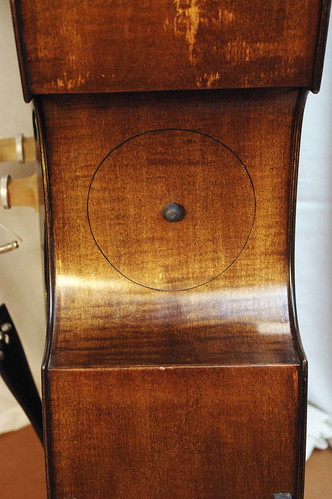First, a few more details about the guitars:
Both are falcate braced.
Both have live backs
The bridges are near identical; consecutive slices off the block, same mass (11.5 grams)
The strings are the same; Savarez 540J (High tension, “carbon”), however, the bass strings on the EIR guitar had been on my string test rig (I ran out of new strings when I needed them and these were the best I had, but this explains the slightly “rubbery” sound in the bass on the EIR guitar; slightly loose windings, methinks)
Action is 4mm and 3mm, both guitars (at least when no capo is applied)
The recordings were made on the same day, probably ~half an hour apart, so humidity change wasn’t a factor (though guitars can sound different at different humidities, for sure)
So, the difference?
The EIR guitar has mass loaded sides and that is responsible for the majority of the sound difference. As well as the tuning benefits (placing of the T(1,1)2) the major acoustical differences are in projection (which I don’t think anyone will be able to detect from the recording) and more “punch” which gives greater articulation and separation at the expense of a slightly slower attack (which to my ears tends to be masked by the extra clarity). The Palo Dorado guitar, live, sounds more like a conventional classical guitar of fan braced ilk, whereas the extra mass in the sides of the EIR guitar gives it a different tone, that could be described as “purer”, having an emphasis on the lower order string harmonics whilst still keeping enough of the higher harmonics to ensure good separation and articulation.
When heard live, the majority of people go for the EIR guitar. However, the Palo Dorado guitar, being lighter, shakes you around a bit more as you play it and some players like that, although it doesn’t do the audience any favours (less volume out front).
And to Ro’s question:
Well, the methods I use ensure that the resonant frequencies of the panels end up more-or-less where I want them, irrespective of the wood species used. That straight away eliminates the majority of the acoustical variables in the wood species mix. The bit that’s harder to control is the sound spectral absorption, which differs by species. Measuring Q or log dec gives a measure of sound spectral absorption at a particular frequency, but I don’t know of a good method to get a spectral view of that. With the side mass thing, you can, of course, put them in or leave them out, so it’s easy to hear the before and after. Putting mass in the Palo Dorado guitar makes it sound very much more like the EIR guitar.MBP wrote:How come it has nothing to do with B&S?
For those interested, we had three Fuji cameras available for the video recording, all “still” cameras with video and sound recording functions, producing .avi files. However, we only used one. The sound was recorded using a single Behringer C-1 condenser mic, phantom power (and nothing else) from a mixer panel, then straight into a Mac running Garage Band. For these two takes the mic was in the same position (you can just see it bottom left of the vids). The sound from the video take was used for syncing the track from Garage Band, which was spliced onto the video using iMovie. The video sound track was then suppressed, leaving the video in sync with the Garage Band track which was then exported to YouTube. Thanks to Damien Geraghty who was playing and Alan Lloyd whose studio, mic and mixing gear he so kindly allowed us to use.
